Early American Half Dimes 1792 - 1837
This earliest half dimes have been the subject of more than two centuries of rumors, innuendo, and conjecture.
The Coinage Act of 1792 established a United States Mint in Philadelphia, the temporary capital of the United States until 1800. This Act also decreed the positions required to operate a national Mint. Importantly, the Act also defined the Dollar as the standard monetary unit and defined all denominations. One of those denominations was the “Half Disme” (pronounced ‘Half-Deem’) and it was defined as follows:
‘Half sixteenth parts of a grain of pure, or twenty grains and four fifth parts of a grain of standard Dismes—each to be of the value of one twentieth of a dollar, and to contain eighteen grains and nine silver.’
This Half Disme coin has been the subject of more than two centuries of rumors, innuendo, and conjecture. Did Washington provide the actual silver used to create these coins? Was the silver from Martha Washington’s favorite tea service? Were these coins patterns or circulating coins? Were they struck at the Philadelphia Mint or elsewhere? Were these coins struck for Washington to present to elected officials and other dignitaries?
President George Washington stated on November 6, 1792, during his fourth annual address to the fledgling nation, his perceptions of the half dime coin:
‘…There has been a small beginning in the coinage of half dismes, the want of small coins in circulation calling the first attention to them.’
One of the recent and most definitive works answering these questions was written by Pete Smith, Joel Orosz, and Len Augsburger and is available on the American Numismatic Association’s website. Titled, “A More Accurate History of the 1792 Half Disme,” it dispels many of the popular folklore notions that previously accompanied these coins.
- Washington did not provide the raw silver used to create these coins.
- The coins should not be considered as patterns, as they were intended and used as circulating coinage.
- They were not provided to friends and elected officials by Washington.
- It was Thomas Jefferson and not George Washington who first promoted and used these new coins.
- There likely were two strikings of these coins—one outside of the Mint in July and one at the Mint in October.
It has been revealed, through his own journals and writings, that Thomas Jefferson, George Washington’s Secretary of State, and the future President, withdrew $75 of his personal funds and had the mint strike the silver into Half Dismes. Approximately 1,500 of these coins were struck between July 11th and 13th in 1792, but they were struck in the private workshop of saw-maker John Harper, a contractor to the Mint. The Mint was not yet operational in July of 1792.
Additionally, the Mint may have struck another 200 to 500 of these Half Disme coins in October of 1792, at the request of Mint Director David Rittenhouse and were saved as souvenirs by Rittenhouse and other Mint officials and staff.
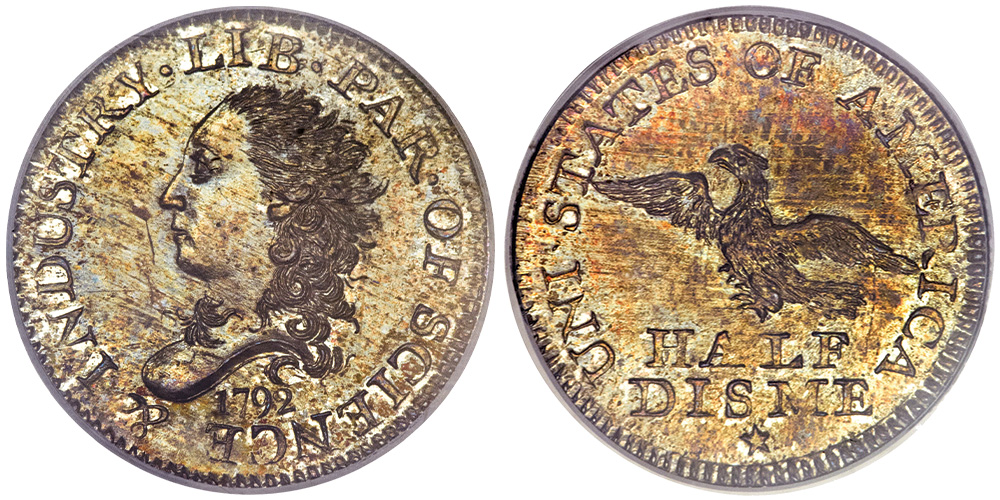
The obverse of the Half Disme coin depicts an allegorical representation of Miss Liberty, facing to the left. Her short hair is flowing wildly behind her and the words, “LIB. (liberty) PAR. (parent) OF SCIENCE & INDUSTRY.”
The reverse displays a small and awkward-looking eagle, which is shown with its wings spread. The motto “UNITED STATES OF AMERICA,” is on the upper periphery and below the bird, in two lines, is “HALF DISME,” with a five-pointed star below the eagle. Made of .8924 silver and .1076 copper, the Half Disme had a diameter of 16.5 mm. The designer and engraver may have been Robert Birch of the United States Mint.
So, credit for the 1792 Half Disme’s popularity likely belongs to Thomas Jefferson rather than George Washington.
No Half Dimes were struck at the United States Mint in 1793, as they were extremely busy striking Half Cents and Large Cents. Robert Scot served as the Mint’s first Chief Engraver. He created the Flowing Hair design for a new Half Dime design which was also used on Half Dollar and Silver Dollar coins during that same period.
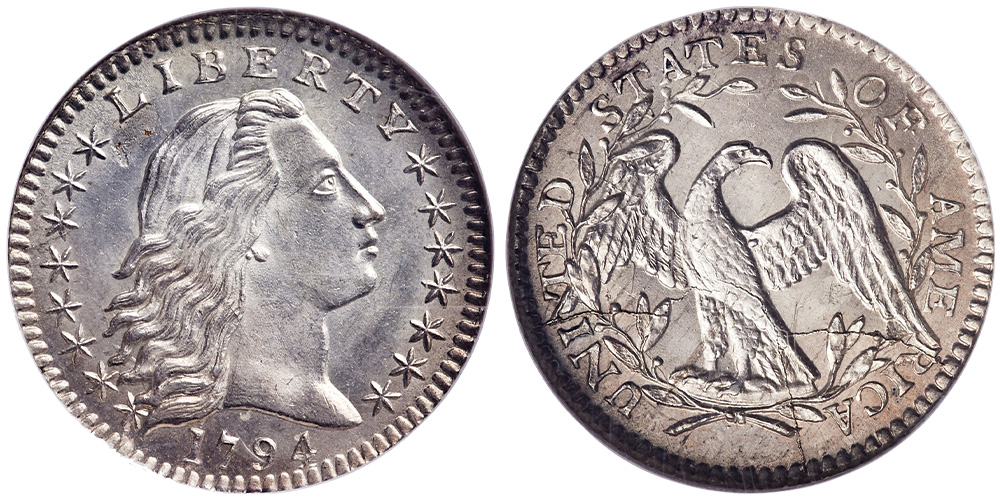
The obverse depicts Miss Liberty facing to the right. Her portrait depicts her long hair flowing behind her. The word “LIBERTY,” adorns the upper periphery and there are eight six-pointed stars on the left periphery and seven six-pointed stars on the right periphery. The date is centered under Liberty’s neck.
The reverse depicts an American eagle with its wings raised upward, and the eagle is centered inside an olive wreath. The upper periphery has the motto “UNITED STATES OF AMERICA.” No denomination is stated on this coin, but the size of the coin indicates its face value. A mere total of 86,416 coins were struck, according to Mint records, but it is believed that only 7,765 were dated 1794, leaving 78,651 to have been dated as 1795. The composition remained as .8924 silver, .1076 copper and the diameter remained at 16.5mm.
For reasons that have been lost to history, the Flowing Hair half dime design existed for only two years. The following year, 1796, the obverse design was radically changed. The new dies were engraved by Robert Scot but may have also been based on a sketch by the Colonial era portrait artist Gilbert Stuart. Stuart, who painted portraits of our first six presidents and many of our Founding Fathers. He is best known for the 1796 portrait of George Washington, which was never finished, but was still used as the basis for his portrait on the One Dollar Federal Reserve Note.
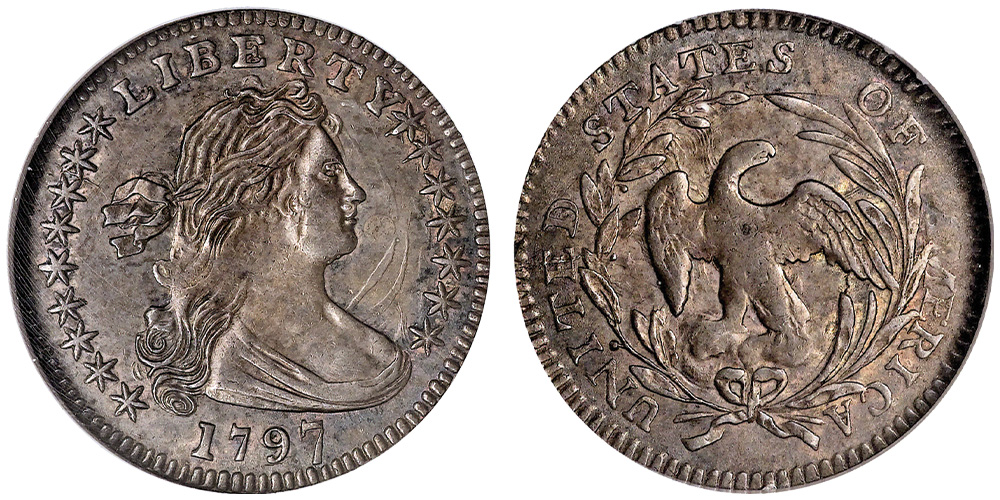
Scot’s depiction of Miss Liberty shows a more friendly-looking allegorical interpretation of her, with her long, flowing hair tied with a ribbon behind her head and drapery covering her shoulders. The word “LIBERTY,” is above her and the date is below. These coins were struck only in 1796 and 1797, and the 1796-dated coins display fifteen stars in the periphery of the obverse—eight to the left and seven to the right. The 1796-dated coins saw a total mintage of 10,230 coins, split into two varieties—a 1796 over 5 dated coin and a variety where “LIBERTY,” is incorrectly spelled as “LIKERTY.”
The 1797-dated coins come in fifteen star and sixteen star varieties, as stars were added when states joined the Union. But the Mint soon realized that unless the number of stars was stabilized at a specific number, they would need to make the stars smaller and smaller as more states were added. The Mint wisely decided to return to thirteen stars to honor the thirteen original colonies. There were 44,527 1797-dated half dimes struck, spread among all three varieties.
The reverse of these Draped Bust Small Eagle coins did not measurably change from the Flowing Hair designs of 1794 and 1795. They still depicted a Small Eagle with upraised wings, centered inside an olive wreath. The upper periphery displays the motto “UNITED STATES OF AMERICA.” No denomination is stated on this coin, but the size of the coin indicated its face value. So, this Draped Bust, Small Eagle coin also followed the Flowing Hair design and became a two-year type coin. No additional Half Dimes were struck again, until the year 1800.
These Half Dime coins were subjected to yet another design change—this time on the reverse only. The Draped Bust obverse remained the same, with the thirteen star motif surrounding the portrait of Miss Liberty.
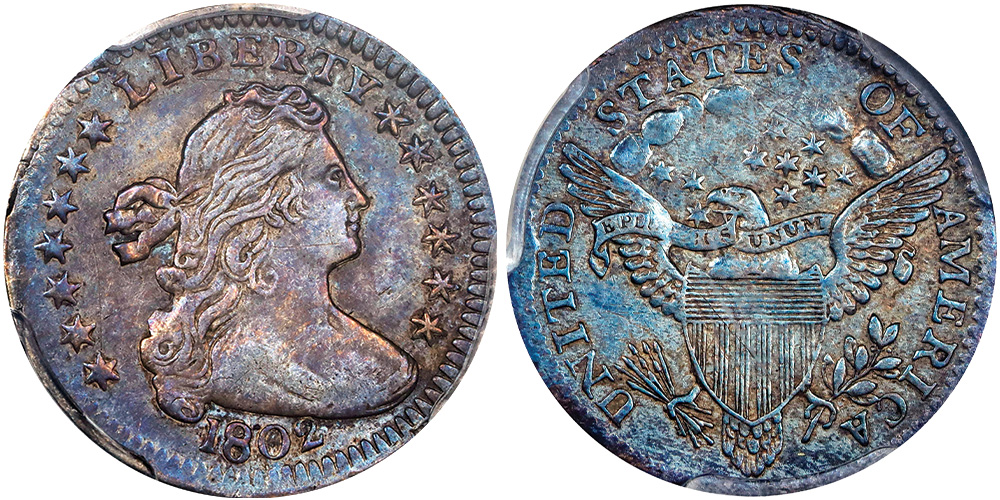
But the reverse was changed dramatically. As the ‘small eagle’ on the reverse had received criticism, especially on the large denominations, as being too ‘scrawny,’ it was modified. It was replaced by the Heraldic Eagle reverse. This new eagle was much larger, had a shield covering its breast, arrows in the eagle’s right talon and an olive branch in its left, a ribbon in its beak with “E PLURIBUS UNUM,” inscribed on it, clouds above the eagle, with “UNITED STATES AMERICA,” around the periphery. This design was first seen on gold Quarter-Eagles and Half-Eagle coins and later silver Half Dollars and Dollar coins. These Draped Bust, Heraldic Eagle Half Dimes were struck between 1800 and 1805, but none were struck in 1804. The coins remained comprised of .8924 silver and .1076 copper.
30,000 coins were struck at the Mint and dated 1800. There are two varieties of this date—the normal 1800 and a version that displays the ‘error’ motto where “LIBERTY,” looks like “LIKERTY.” 24,000 coins were of the normal date and 16,000 coins were struck with the “LIKERTY” motto.
The year 1801 saw 27,760 coins struck with no major varieties struck. In 1802, a mere 3,060 coins were possibly minted but US Mint records are incomplete. This date is one of the classic rarities of the United States coinage series. It is believed that only sixteen specimens are known to exist today and when any specimen comes up for auction it is truly a numismatic event.
There were two major varieties of 1803-dated Draped Bust, Heraldic Eagle, Half Dimes that were a “Large 8,” and a “Small 8,” among the 37,850 1803-dated coins that were struck. The ‘Small 8’ variety is two to four times rarer depending upon the condition. While there were no 1804-dated Draped Bust Half Dimes struck, the 1805 coins saw only 15,600 coins struck and no major varieties. No date in this Draped Bust, Heraldic Eagle series experienced a mintage of even 40,000 coins struck.
During the period from 1806 through 1828, no half dime coins were minted. This happened for a variety of reasons. The US Mint created silver coinage but much of it was hoarded. Unlike Half Dollar and Silver Dollar coins, the intrinsic value of Half Dimes, Dimes and Quarters was so small that these coins were generally not exported.
The primary reason these small silver coins were not struck in quantity was that a considerable number of Spanish, Mexican and other small silver coins from foreign countries circulated freely. These foreign coins remained as legal tender until the passage of the Coinage Act of 1857. American merchants and citizens were comfortable using Half Real ($0.0625 cents), One Real ($0.125 cents) and Two Real ($0.25 cent) coins for their daily commerce.
On July 4, 1829, coinage of a newly-designed Half Dime began to enter circulation. These coins were designed by William Kneass, the 2nd Chief Engraver of the United States Mint. He served between 1824 and until his death in 1840. Kneass modified John Reich’s design and created the Capped Bust Half Dime, style.

These coins were struck between 1829 and 1837 and were struck at the Philadelphia Mint in sufficient quantities (from 800,000 coins to 2,700,000 coins) through the run of dates making them available to most collectors. Like their predecessors, their composition was made from .8924 silver and .1076 copper.
The obverse of these coins depicts an allegorical representation of Miss Liberty, facing to the left. Seven six-pointed stars adorn the left side of the outer periphery, and six stars are on the right. The upper periphery displays the word “LIBERTY.” The date of minting sits below Miss Liberty. She is wearing a Phrygian cap, with a band on which is inscribed the word “LIBERTY.” Her hair flows behind her and her gown is fastened with a brooch.
The reverse displays an American eagle, facing left, with wings spread and slightly upraised. A patriotic shield protects her breast. The eagle is perched on a branch as she holds arrows in her talon. Above the eagle is a banner on which is inscribed with “E PLURIBUS UNUM,” Below the eagle is the first time a denomination appeared on a coin, as a simple “5 C.” While there are no rare dates, varieties abound with Small and Large Dates and Small and Large Denominations. This Capped Bust series design was replaced in 1837 by Christian Gobrecht’s Seated Liberty design which was struck through 1873, when the Half Dime denomination was finally discontinued.
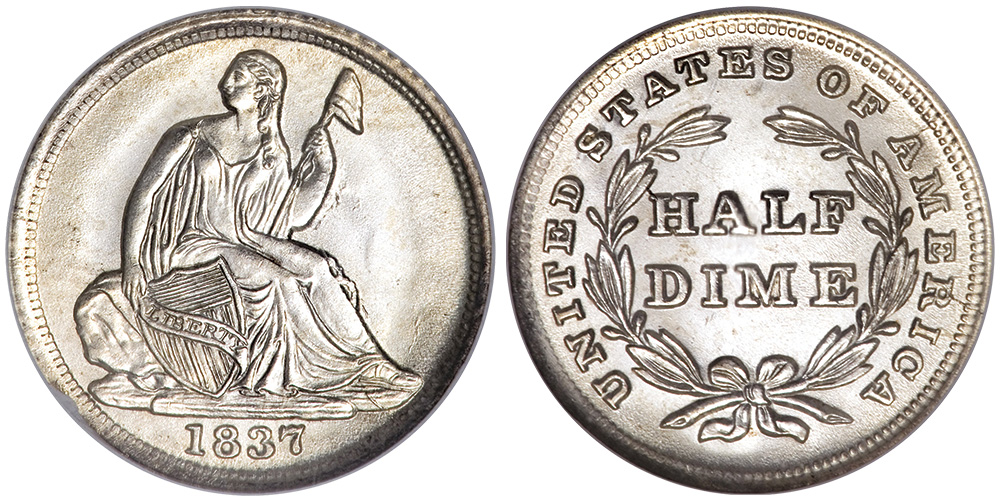

Download the Greysheet app for access to pricing, news, events and your subscriptions.
Subscribe Now.
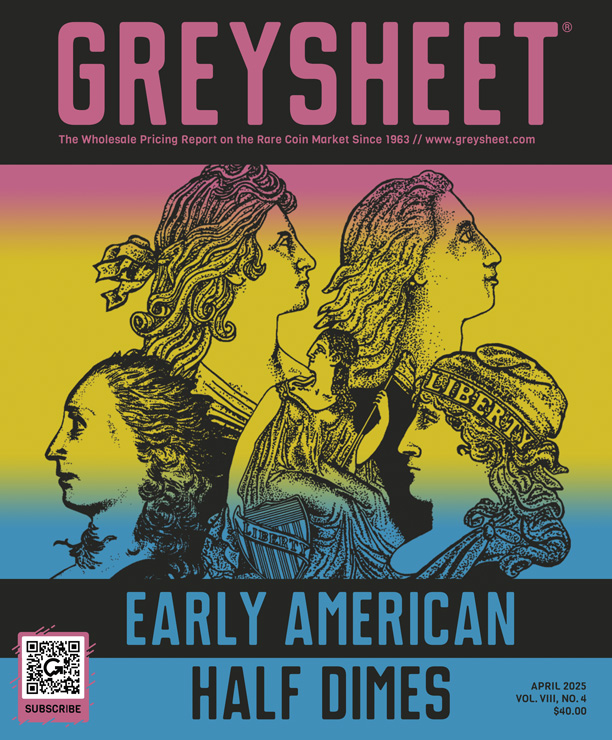
Subscribe to The Greysheet for the industry's most respected pricing and to read more articles just like this.
Author: Michael Garofalo
Related Stories (powered by Greysheet News)
View all news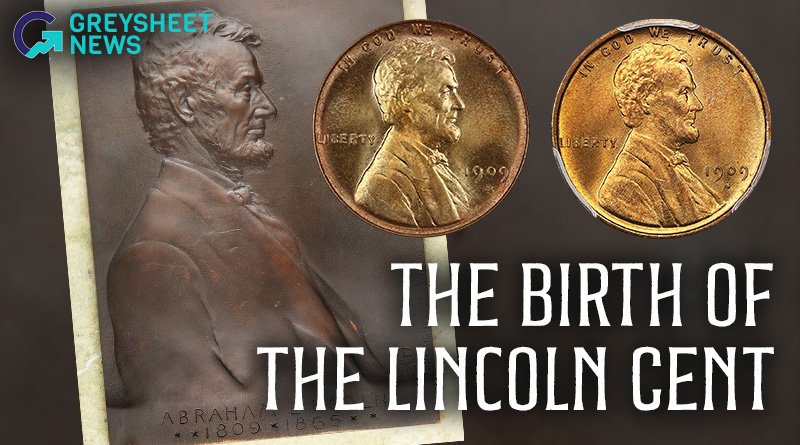
For the U.S. to place an image of a real historical person, even one as legendary as Lincoln, on a coin took great courage.
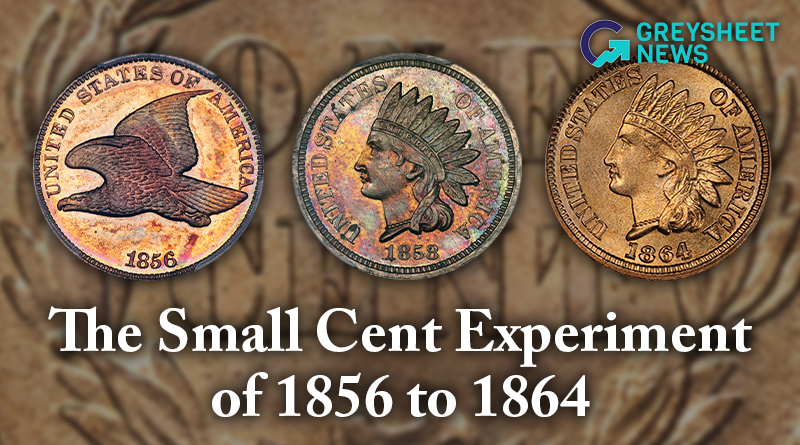
The Coinage Act of 1792 established the United States Mint in the then-capital of Philadelphia. The Act provided requirements for United States coinage, the creation of various Mint positions and the duties incumbent on the principals and established the United States Dollar as the standard unit of currency.

An overview of how the gold dollar originated and evolved in the mid-1800s.


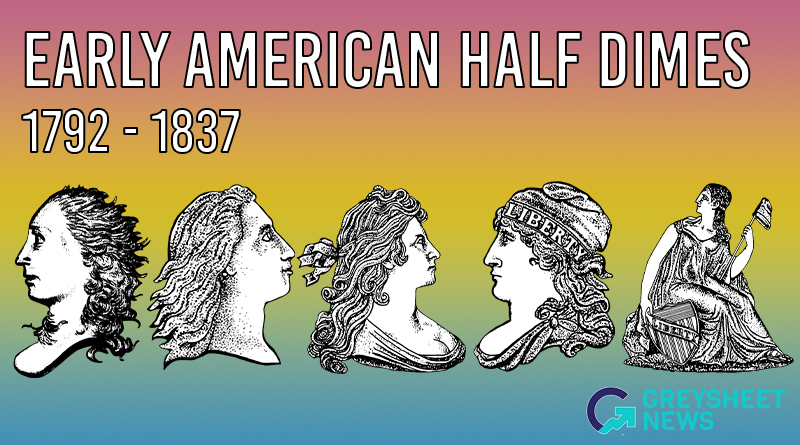






Please sign in or register to leave a comment.
Your identity will be restricted to first name/last initial, or a user ID you create.
Comment
Comments